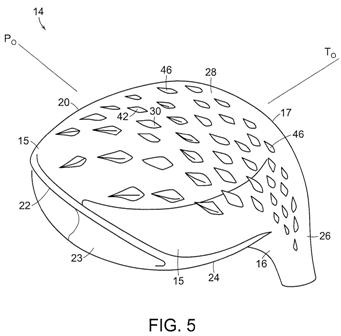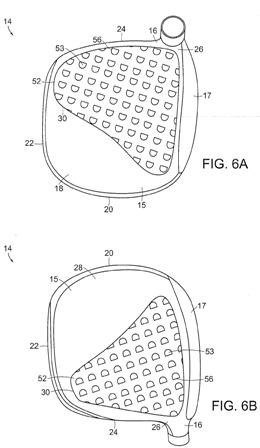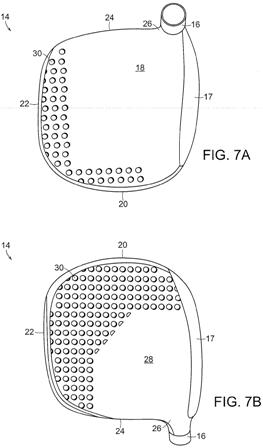Nike Golf’s Twist on the Dimpled Golf Club Head
Recall my recent sarcastic post titled “Clearly the World’s Most Aerodynamic Golf Club Head”? Well, check out Nike Golf’s twist on this old concept.




The drawings come from a patent application that recently published as US Pub. No. A golf club head includes a body member having a ball striking face, a crown, a toe, a heel, a sole, a rear and a hosel region located at the intersection of the ball striking face, the heel, the crown and the sole. A plurality of dimples are located on the hosel region, on the crown, on the sole, and/or on the heel, wherein at least some of the plurality of dimples have a major axis that is not aligned in a direction parallel to the moment-of-impact club-head-trajectory direction. A golf club including the golf club head is also provided.
The application explains:
BACKGROUND
[0002] The distance a golf ball travels when struck by a golf club is determined in large part by club head speed at the point of impact with the golf ball. Club head speed in turn can be affected by the wind resistance or drag provided by the club head during the entirety of the swing, especially given the large club head size of a driver. The club head of a driver, fairway wood or metal wood in particular produces significant aerodynamic drag during its swing path. The drag produced by the club head leads to reduced club head speed and, therefore, reduced distance of travel of the golf ball after it has been struck.
[0003] Reducing the drag of the club head not only at the point of impact, but also during the course of the entire downswing prior to the moment of impact, would result in improved club head speed and increased distance of travel of the golf ball. When analyzing the swing of professional golfers, it has been noted that the heel/hosel area of the club head leads the swing during a significant portion of the downswing and that the ball striking face only leads the swing at (or immediately before) the point of impact with the golf ball. The phrase “leading the swing” is meant to describe that portion of the club head that faces the direction of swing trajectory. For purposes of discussion, the golf club and golf club head are considered to be at a 0 degree orientation when the ball striking face is leading the swing, i.e. at the point of impact. It has been noted that during a downswing, the golf club is rotated by 90 degree or more around the longitudinal axis of its shaft (yaw) during the 90 degree of downswing prior to the point of impact with the golf ball. During this same portion of the downswing, the club may be accelerated to approximately 65 miles per hour (mph) to over 100 mph, and in the case of a professional golfer, to as high as 140 mph.
[0004] Club heads that have been designed to reduce the drag of the head at the point of impact, or from the point of view of the club face leading the swing, may not function well to reduce the drag during other phases of the swing cycle, such as when the heel/hosel region of the club head is leading the downswing.
Think this will be Rory’s new driver?
